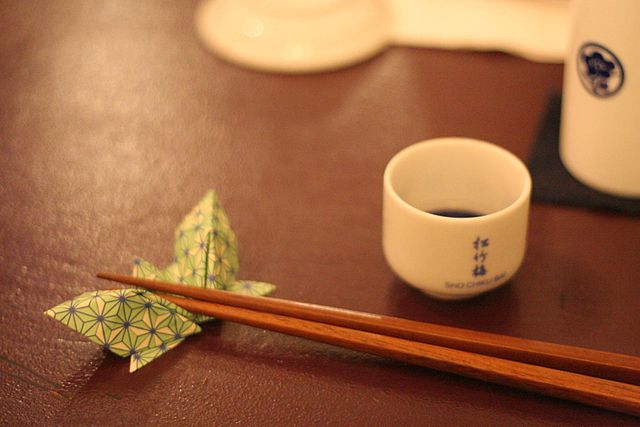The Land of the Rising Sun is one of the most welcoming for travellers, but like any country, they have their own unique culture and etiquette to abide to.
It may be hard to adhere to all of the customs, but if you follow our guide to Japanese etiquette for the first-time visitor you will at least be armed with a knowledge of what to do and when.
Food and Drink
Jessica Korteman, from Notes of Nomads, has helped to set up a blog that shows off the best the world and their adoptive home of Japan has to offer.
“Food and drink is an important part of the Japanese cultural experience, and you should definitely experience as much of the local cuisine on your trip as possible. However, there are a couple of things to keep in mind when dining out or grabbing a snack in between sightseeing activities to fit in with local culture and etiquette.”
Chopsticks
Chopsticks are often utensils that stump many people and there is certainly a couple of things that you must – and mustn’t – do when it comes to using them.
You should never leave your chopsticks standing upright in your bowl, or use them to pass food to someone else’s sticks. Another is to not ‘play’ with them, like waving them around, pretending to be a walrus or itching yourself.
Top-ups
Drinking can be an issue for those who are non-drinkers, or only drink in small amounts. In Japan it is custom to fill up someone’s glass once it gets below half way, so if you really don’t wish to drink or want to stick to a small amount then just ensure that you are going slowly and keep your glass half full, that way it won’t be refilled.
It is common place to pour for other people, for instance if you are a guest you will have your drinks poured for you. If you refill your own glass, it can give the impression that you think your host is not being attentive.
Jessica explained the etiquette surrounding drinking in Japan and how best to approach it.
“One important rule when dining with others in a more formal setting is to not pour your own drink. Instead offer to serve others and leave your own glass. Don’t worry, someone else in the group will fill yours up soon after. Similarly, if someone pours yours first, be sure to reciprocate and not leave that person’s glass empty.”
Similarly, if you see that someone is running a little dry then pour it for them, it will more than likely be accepted with a smile.
Remember to call “kampai”, which is cheers in Japanese, before you drink.
Portion control
If you are in a position where you are helping yourself to food, it is a must that you finish everything on your plate.
Like across many parts of the world, adding condiments or anything to enhance your food is considered rude and an offence to the chef. You will often find that you are offered a small bowl of soy sauce for example, in this case you can use some but refrain from using it all.
When you receive your food in Japan you may find that you are given more than you can eat, and may even be offered more when you know you are full. Rather than refusing it, loosen your belt and say ‘thank you’, it may mean a slightly uncomfortable few moments after your food but they do have your best interests at heart and are only ensuring that you are not walking away hungry.
Slurping
You are more than likely going to come across a dish which is particularly hard to eat, but do not be ashamed to slurp. If you visit any noodle restaurants you are going to be surrounded by locals who are slurping their way through their meal, so don’t be afraid to get your head down and enjoy your food.
Jessica explained that slurping is common place in Japan:
“Slurping your drinks, soup and noodles is usual in Japan, in fact, it’s considered polite as it shows your enjoyment of the meal. However, if you can’t quite bring yourself to slurp away in public, there are other simple ways to be polite while dining out.”
Tipping – and exchanging money
Though tipping is common in the western-world, there is no custom of it in Japan. Even if you leave just the smallest amount of change in restaurant, you will likely be chased down by your waiter trying to give it back, as Jessica explains:
“When leaving, you can show your appreciation for the food in words to either your friends (if they cooked for you) or to the staff of the restaurant, by saying gochisousama deshita – thank you for the feast!”
At some of the more upscale establishments, gratuity may be included in the bill.
On the move
Having moved from Melbourne to Tokyo, Jessica understands the surprise that first-time visitors walking through the streets and not seeing any bins but there is good reason for it.
“You should avoid eating while walking. While many anime depict Japanese daily life with astounding accuracy, the part where one of the characters inevitably grabs a piece of toast before running out the door is a completely foreign concept for most Japanese. Many find it embarrassing to eat on-the-go and some may believe it to be rude. Festivals and snack streets aside, where walking and eating on the street is usual, try to avoid uncomfortable glares by finding somewhere appropriate to stop and have your snack.”
In contrast to western-culture where you see many tourists manoeuvring around the streets with an ice-cream in hand, in Japan you will very rarely see anyone eating as they walk.
This very small act helps to make the streets of Japan some of the cleanest around, despite being hard-pressed to find a bin. Not only is carrying around a used piece of wrapping or an empty bottle inconvenient, eating or drinking as you walk will draw unnecessary attention to you.
In public
Escalators
For anyone who lives in the city, you will know that there are certain rules that comes to escalators, and not adhering to them can certainly frustrate many people.
Like anywhere, escalators have a ‘fast’ and ‘slow’ lane in Japan. In Osaka you are expected to stand on the right and pass on the left, whereas in Tokyo you stand on the left and pass on the right.
As with anywhere, if you are unsure just have a look around and see what other people are doing.
On the phone
If you are travelling via public transport, you may notice announcements encouraging passengers to switch their phones to silent.
In Japan it is considered rude to speak on your mobile while on a train or bus and similarly, speak quietly when with your fellow passengers.
Under the weather
You will probably notice people walking around the streets with surgical style masks, this is because the person is ill and is trying not to pass on their ailment to anyone else.
In the same respect, you should avoid blowing your nose in public places.
Taxis
This is as much a bit of friendly advice, as much as it will save you a great deal of embarrassment and confusion: do not try and open taxi doors in Japan.
Taxi drivers can open the doors with a button, so try to remember not to go for the handle yourself. The same goes for exiting the vehicle, the door will open for you.
Queuing
Much like us Brits, the Japanese are very good at forming orderly and patient queues when waiting for something.
But unlike the London Underground, you will notice that at Japanese train platforms it is much less of a ruck to fight your way onto the train, but a much politer orderly line marked out by drawings on the platform.
Cory Varga, the founder of You Could Travel explains how Japan has developed over time to fit around its population growth.
“One of the great things in Tokyo is that, although overpopulated, this city is efficient and it just works. Each and every resident contributes to making Tokyo functional
“One of the things I’ve noticed is how peculiar the locals are about keeping to a certain side of the road. The city scribbles and signs painted on the pavement. People rushing, have their own dedicated lane, which can leave the odd tourist feeling confused, as to why people are trying to overtake for no apparent reason. It is common courtesy that you move aside from any marked lane to allow any rushed local to get to its destination, fast.
“Lanes and markings are predominant in the subway and train stations too. Make sure to form an orderly queue and step right on the correct markings. When taking the Shinkansen, check your ticket and only queue in front of your corresponding train carriage.”
Dress code
Some accommodation in Japan will provide room wear, like slippers, dressing gowns or traditional yukatas. Commonly, wearing these clothes should be restricted to your rooms, unless you are told that you can do otherwise.
Interactions
Bowing
Bowing is a major part of interacting in Japan, from bowing when you meet, to say thank you or if you are saying goodbye.
Tourists are not expected to understand bowing in depth, duration and number of bows involved but Japanese people are not going to be offended.
If you are unsure, a bow of the head is a sufficient greeting but you can also shake hands. To be sure, it is always best to wait for the opposite party to initiate the greeting.
Gift giving
When it comes to gift giving, or receiving, you should always return the compliment with something that has equal or greater value. You can refuse a gift after the first offer, but if you are presented with something a second time you must accept.
If you have accepted the gift you should kindly thank them (even with a bow) and take it home to open – unless they have asked you to open it in front of them. When visiting someone’s house or attending an event you should always bring a gift and make sure that it is thoughtfully wrapped – the majority of stores will professionally do this for you.
Speaking softly
The Japanese are particularly softly spoken in public places, with the language itself suited to quiet conversations.
Loud or intense conversations can be surprising and appear rude, so consider lowering your voice in social surroundings.
Punctuality
Punctuality is very important in Japan, and is certainly one thing that you should adhere to if you are looking to book a tour to Japan.
If you are on a group tour for example, it is in your best interest to make sure you follow the timings given. Organisers, if Japanese, can become a bit flustered by any tardiness and it is always worth considering your fellow tour members who may become fed up.
For the lowdown on when to go, take a look at our Best Time to Visit Japan page
 Book a Japan tour and put your new Japanese etiquette skills to use with the UK’s leading Asia Experts, Wendy Wu Tours. Our award-winning escorted tours in Japan visit all the major sights for an unforgettable holiday.
Book a Japan tour and put your new Japanese etiquette skills to use with the UK’s leading Asia Experts, Wendy Wu Tours. Our award-winning escorted tours in Japan visit all the major sights for an unforgettable holiday.
We also have tours to China, Southeast Asia, India and more…
Image Credit: k_t, Orin Zebest (Wikipedia Commons)




























